
95% of researchers rate our articles as excellent or good
Learn more about the work of our research integrity team to safeguard the quality of each article we publish.
Find out more
ORIGINAL RESEARCH article
Front. Psychol. , 28 October 2015
Sec. Auditory Cognitive Neuroscience
Volume 6 - 2015 | https://doi.org/10.3389/fpsyg.2015.01646
 Alice M. Proverbio1*
Alice M. Proverbio1* Luigi Manfrin2
Luigi Manfrin2 Laura A. Arcari1
Laura A. Arcari1 Francesco De Benedetto1
Francesco De Benedetto1 Martina Gazzola1
Martina Gazzola1 Matteo Guardamagna1
Matteo Guardamagna1 Valentina Lozano Nasi1
Valentina Lozano Nasi1 Alberto Zani3
Alberto Zani3Previous studies suggested that listening to different types of music may modulate differently psychological mood and physiological responses associated with the induced emotions. In this study the effect of listening to instrumental classical vs. atonal contemporary music was examined in a group of 50 non-expert listeners. The subjects’ heart rate and diastolic and systolic blood pressure values were measured while they listened to music of different style and emotional typologies. Pieces were selected by asking a group of composers and conservatory professors to suggest a list of the most emotional music pieces (from Renaissance to present time). A total of 214 suggestions from 20 respondents were received. Then it was asked them to identify which pieces best induced in the listener feelings of agitation, joy or pathos and the number of suggested pieces per style was computed. Atonal pieces were more frequently indicated as agitating, and tonal pieces as joyful. The presence/absence of tonality in a musical piece did not affect the affective dimension of pathos (being touching). Among the most frequently cited six pieces were selected that were comparable for structure and style, to represent each emotion and style. They were equally evaluated as unfamiliar by an independent group of 10 students of the same cohort) and were then used as stimuli for the experimental session in which autonomic parameters were recorded. Overall, listening to atonal music (independent of the pieces’ emotional characteristics) was associated with a reduced heart rate (fear bradycardia) and increased blood pressure (both diastolic and systolic), possibly reflecting an increase in alertness and attention, psychological tension, and anxiety. This evidence fits with the results of the esthetical assessment showing how, overall, atonal music is perceived as more agitating and less joyful than tonal one.
The aim of the study was to investigate the possible effects of atonality music and emotional characterization on autonomic responses. While many studies have explored the neural mechanisms of music perception by measuring electrophysiological, neuroimaging, or physiological parameters during music listening (Koelsch, 2014), so far little attention has been paid to the effect of musical style, particularly the presence or absence of tonality, on the esthetic experience. For example, some studies defined contemporary atonal music as “adiabatic”; that is, incapable of transmitting emotions (Frova, 2008). Other scholars have defined it as “entropic” (random, disordered, information-less; see Donin and Feneyrou, 2013), but few studies have been carried out in the field of neuroscience.
Generally speaking, from a perceptual point of view two main differences exist between tonal and atonal music. (1) The presence of a clear and predictive harmonic structure in the former, and (2) the presence of acoustic dissonances in the latter. Overall, tonal pieces are perceived as more congruent and less unexpected than atonal pieces, which violate consonance rules and general music expectations about structure and harmony (e.g., Meyer, 1956; Pearce and Wiggins, 2012). Indeed, it is more difficult to identify the musical structure of atonal pieces, especially for non-expert listeners (Daynes, 2011), and this may reduce music appreciation. On the other hand, experienced listeners attending to serial music may indeed be able to detect certain aspects of its artificial compositional grammar (e.g., the eschewal of pitch repetition), or other types of structures (Ockelford and Sergeant, 2012) not necessarily designed by the composer. This greater understanding is associated with a greater esthetic appreciation. Violations and confirmations of musically induced expectations may be able to affect related psychophysiological activations. In an interesting study Egermann et al. (2013) found a general increase of physiological arousal to unexpected musical events or endings (e.g., note’s pitch) in terms of heart rate and facial expressivity, thus showing how music structure per se can heavily affect induced feelings, regardless of music emotional characterization.
Tonal and atonal music also differ considerably from the perceptual point of view, because the latter is full of dissonances and inharmonic chords. It was shown that the perception of inharmonic isolated sounds or chords elicit physiologically different responses in newborns (Perani et al., 2010; Virtala et al., 2012) and human adults (Bidelman and Krishnan, 2009; Bidelman and Heinz, 2011), as well as in other species, such as macaques (Macaca fascicularis, Fishman et al., 2001), chimpanzees (Pan troglodytes, Sugimoto et al., 2010) and rats (Rattus norvegicus, Crespo-Bojorque and Toro, 2015). Although there is some evidence that listening to tonal or atonal music partially activates different brain regions (Minati et al., 2009), the neurophysiological correlates of perceiving atonal music remain a rather unexplored matter.
Zentner et al. (2008) analyzed participants’ reports of felt emotions in response to music listening. The factorial analysis revealed nine esthetic dimensions: wonder, transcendence, nostalgia, tenderness, peacefulness, joyful activation, tension, sadness, and power. It is very likely that many felt emotions shared some of their psychophysiological and neurophysiological substrate. And indeed, Vuilleumier and Trost (2015) showed that complex music-induced feelings (such as wonder, nostalgia, or tenderness) shared common neural substrates. Feelings of power (i.e., being heroic and triumphant) were correlated with the activation of the ventral striatum, similar to the effect of joy but with distinctive increases in the motor cortex and dorsal basal ganglia. On the other hand, wonder (i.e., feeling allured and amazed) also activated the ventral striatum, but unlike joy and power, it activated the motor areas to a lesser degree and the right hippocampus to a greater degree. Nostalgia and tenderness were found to activate the hippocampus, and nostalgia produced increased activity in the brain regions involved in visual imagery. Overall, the available literature suggests that the stimulation of feelings by music might solicit complex but shared associations based on partially overlapping neural mechanisms (Peretz and Zatorre, 2003; Brattico and Pearce, 2013). On the other hand, joy, fear and sadness, among the emotions more commonly studied in research on music and emotion (Zhao and Chen, 2009; Huron, 2013; Kawakami et al., 2013; Liégeois-Chauvel et al., 2014; Hopyan et al., 2015) are pretty distinctive in terms of their biological substrates.
In this study, to possibly detect some changes in autonomic parameters during music listening, only music-induced affective categories that were quite distinctive in terms of their biological substrates were considered, namely: joy, pathos, and agitation. These categories are based on a rough subdivision in: (i) positive mood (joy, well-being, good mood, satisfaction, pleasure), associated with a cholinergic autonomic response, and, neurally with the activation of the ventral tegmental area (VTA) and striate cortex, the dopaminergic reward circuitry, the orbitofrontal cortex, nucleus accumbens (Blood and Zatorre, 2001; Koelsch et al., 2006); (ii) pathos (sadness, pain, commotion, nostalgia, tenderness, sympathy), associated with the activation of the insula, cingulate cortex, ventromedial prefrontal cortex, and hippocampus, along with high prolactin concentrations (Janata, 2009; Trost et al., 2012; Huron, 2013); and (iii) agitation (surprise, fear, tension, excitement, anxiety), associated with an adrenergic sympathetic autonomic response, and the activation of the amygdala, motor cortex, cerebellum, etc. (Koelsch et al., 2006; Gosselin et al., 2007; Brattico and Pearce, 2013; Stupacher et al., 2013).
As for the effects of music-induced feelings on the autonomic nervous system (ANS) the available psychophysiology literature is rather inconsistent (Krabs et al., 2015). For example, some studies demonstrated an increase in heart rate with arousing music and a decrease with tranquilizing music (e.g., Bernardi et al., 2006), and others reported increases in heart rate with arousing as well as tranquilizing music (e.g., Iwanaga et al., 2005). Thus, one intervening factor might be the music-evoked emotional valence. Several studies reported that compared to negative valence (displeasure), positive valence (pleasure) is associated with higher heart rate (e.g., Sammler et al., 2007). However, other studies (e.g., Etzel et al., 2006) failed to find effects of music-evoked emotional valence on heart rate. Again, it has been shown that listening to music can reduce pain intensity and systolic blood pressure in patients during post-operative recovery (Chen et al., 2015). Furthermore, it can reduce stress levels and heart rate in patients with coronary heart disease and cancer (Tan et al., 2015), but no reductions in heart rate or blood pressure in healthy controls were caused by listening to music. In another study by Radstaak et al. (2014), it was shown that although listening to both relaxing and happy music improved subjects’ moods, it did not diminish systolic blood pressure. In another psychophysiological study by Tan et al. (2014), the effect of relaxing music on the recovery of heart rate after exercise was investigated. Twenty-three healthy young volunteers exercised on a treadmill and were then assessed for heart rate recovery and subjected to saliva analysis. The participants were either exposed to sedating music or to silence during the recovery period immediately following the treadmill exercise. No differences were found between exposure to music or silence with respect to heart rate recovery, resting pulse rate, or salivary cortisol, but again, no effect of tonal music was explored. It should be considered that in all studies taken into account the music listened to was relaxing, sedating or tranquilizing in nature, therefore one might expect to find cholinergic responses associated with listening to this sort of music. On the other hand, a parasympathetic defensive reaction such as the so called fear-induced “bradycardia” (Hermans et al., 2013) has not been reported, so far, as a result of listening to classical music. It is commonly produced by the abrupt presentation of intense, noxious or scary sounds, both in animals (Young and Leaton, 1994; Kalin et al., 1996) and in humans (e.g., Anderssen et al., 1993). A fear bradycardia has also been observed during perception of scary or violent movie scenes (Palomba et al., 2000).
The effect of atonality on autonomic parameters has been rarely investigated, except for a study in which the respiratory sinus arrhythmia was measured in 40 mothers and their infants while listening to tonal and atonal music (Van Puyvelde et al., 2014). The authors found no effect of atonal music in mothers but only in infants. Again, Krabs et al. (2015) compared listening to pleasant tonal and unpleasant dissonant music with silence, and found an increase in heart rate during music listening vs. silence but no effect of music pleasantness (and dissonance) on the cardiac response.
In our study, to select tonal or atonal pieces characterized by a given emotional connotation, a group of musicians was asked to indicate some representative pieces that best expressed a given emotion: the number of suggested pieces per emotion and musical style was calculated. The professional suggestions that overlapped more coherently were selected for the experiment. The physiological responses of large group of non-musicians with no education and little interest in music were measured while they listened to music excerpts of various styles (specifically comparing tonal vs. atonal music). In fact, one of the main problems with this type of investigation is that esthetic preferences are strongly mediated by music exposure and education. We assumed that because our participants were not educated and not particularly interested in classical music, they would have been casually exposed to tonal and atonal music through random listening in public places, where music is often played to create an atmosphere or reduce stress. Indeed, in everyday life, we happen to involuntarily (and forcedly) listen to many different types of background music (from pop to jazz, techno to classical) while watching television commercials, waiting on hold on the phone, or when we enter a bar, a restaurant, an airport, or a mall. Many television programs and movies are associated with an atonal soundtrack (especially dramas, horror movies, and thrillers, or when shocking revelations are to be expressed). Therefore, in this study, the effect of “exposure to music” was not completely annulled because participants (university students living in the Milan metropolitan area) belonged to a specific Western society. However, it should be known that the study’s aim was not to establish to what extent the esthetic appreciation depended on evolutionary, anatomical or physiological constraints or whether it was influenced by cultural, historical, and individual differences (Konecni, 1979; Jacobsen, 2010). To follow an ecological approach, we chose to make the participants listen to real tonal or atonal artworks and masterpieces, instead of presenting them simple melodies, chords, or fragments of little artistic value (see Van Puyvelde et al., 2014; Krabs et al., 2015).
A paper questionnaire was given to teachers in the local conservatory of music and an email questionnaire was sent to about 50 music professionals whose email addresses were found in the homepages of CIDIM (database of Italian musicians) and Italian music conservatories. Twenty musicians responded enthusiastically and were recruited for the study. They were 20 professional conductors, composers and professors of various Italian conservatories whose mean age varied between 50 and 60 years. The prestigious and excellent careers of all judges included intensive teaching, national and international performances in famous theaters, CD recordings, live television recordings, masterclasses, and award.
The judges were asked to freely provide a list (between 5 and 15) of the most emotional classic instrumental music pieces from the tonal and atonal repertoire. Instructions were: “Please kindly indicate in the relative boxes the musical pieces that, based on your personal experience, are emblematic of three affective categories: agitating, happy, or touching music.”
Agitating was defined as music that transmitted anxiety, distress, fear, agitation, and tension.
Happy was defined as music that transmitted a good mood, wellness, joy, and happiness.
Touching was defined as music that transmitted pathos, grief, melancholy, pain, sadness, nostalgia, and sympathy.
Tonal music was defined as any musical production that had a tonal center around which the melody and harmony were based, including the monodic productions of the Middle Ages.
Atonal music was defined as any musical production (roughly dated after 1910: from Schönberg onward) that avoided a tonal center or used multiple tonal centers simultaneously. After their initial selection, movie soundtracks, opera pieces and excessively popular pieces were discarded.
A total of 207 suggestion was received: 147 tonal pieces and 60 atonal pieces. Similarly to Kallinen (2005), who asked composers and Conservatory teachers to nominate musical works that expressed specific emotions, we found that a higher proportion of tonal works were selected than non-tonal works. As expected, the music professionals suggested more music based on the diatonic major/minor than the amodal/atonal or dodecaphonic system (i.e., Renaissance, 21th-century).The corpus of suggestions was re-submitted to judges, asking them to identify the most touching, joyful, or agitating pieces among the ones listed (if any, and according to their esthetic preference). Unlike in Kallinen (2005) study, in which suggestions for typical basic emotional music excerpts overlapped minimally (i.e., there were only a few pieces that were mentioned more than once or twice), many pieces received a coherent categorization from the judges, in our study.
Overall, the 20 judges provided 123 esthetic evaluations (about six pieces per judge) for the 60 atonal pieces and 319 evaluations (about 16 pieces per judge) for the 147 tonal pieces (Figures 1 and 2). The number of suggested pieces per emotion and musical style was calculated and descriptive statistical methods and Wilcoxon testing were used to analyze the data. The evaluations were attributed as follows: 12.2% of pieces were attributed to agitating, 42% to touching and 45.8% to joyful categories for the tonal repertoire; 39% of pieces were attributed to agitating, 43.1% to touching and 17.89% to joyful categories for the atonal repertoire.
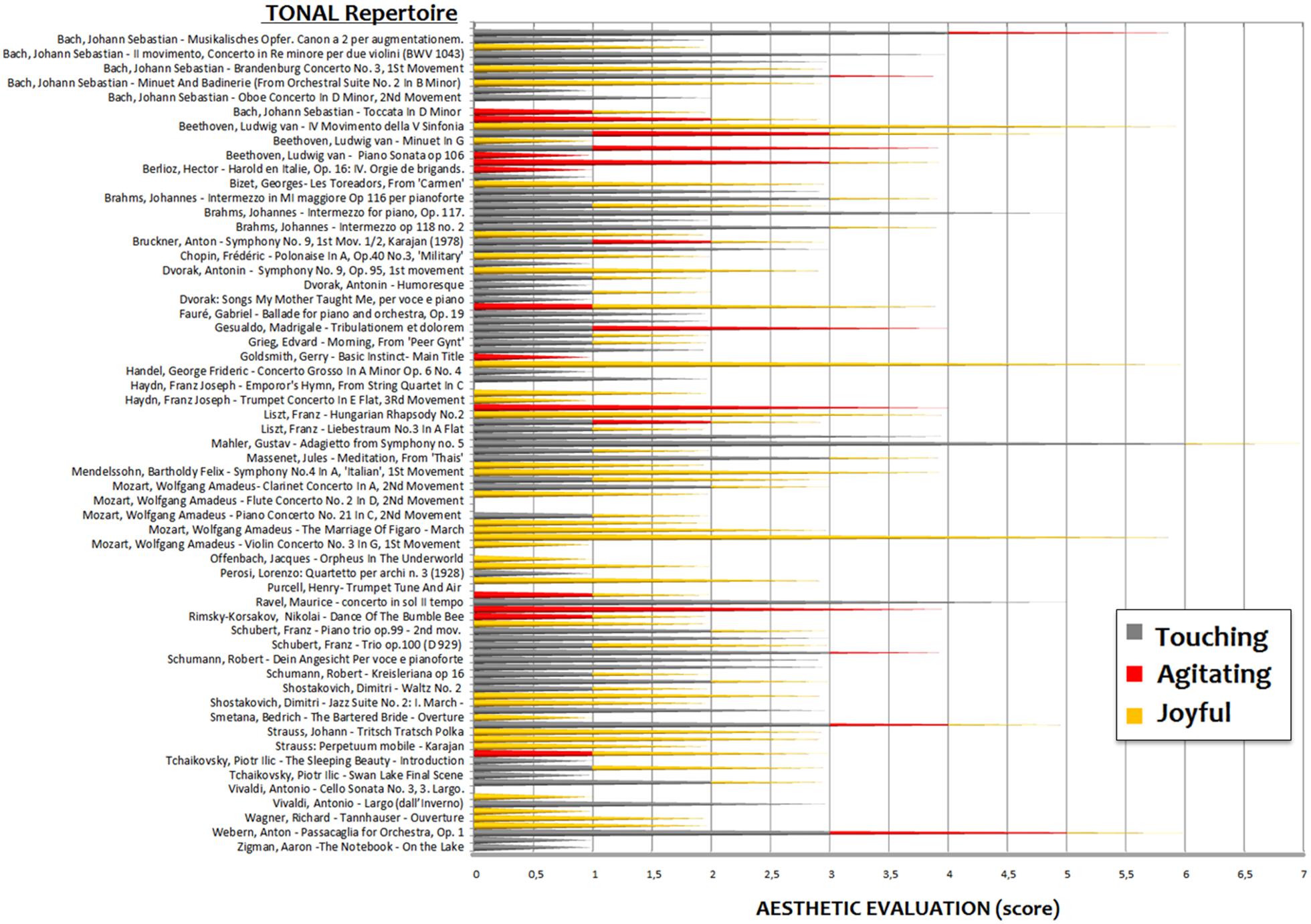
FIGURE 1. Esthetic assessment of tonal artworks with respect to the three emotional categories (according to the evaluations of 20 conductors, composers, and conservatory professors). As in Kallinen (2005) emotional categorization showed a marked inter-individual variability. However, (unlike in the above study, in which there were only a few pieces that were mentioned more than once or twice to illustrate a given emotion), many pieces were categorized in an extremely coherent manner.
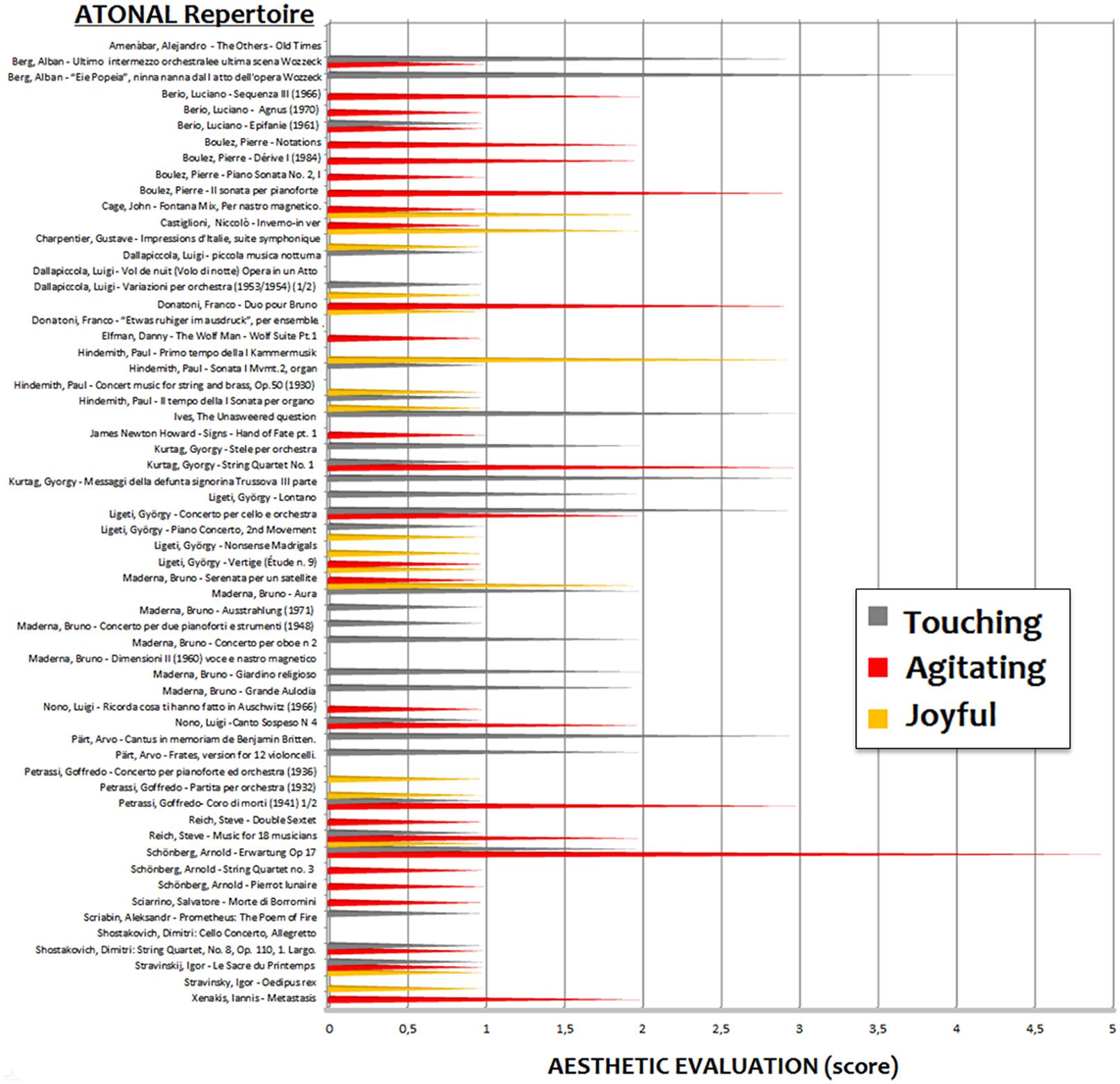
FIGURE 2. Esthetic assessment of atonal artworks with respect to the three emotional categories (according to the evaluations of 20 conductors, composers, and conservatory professors).
As can be clearly appreciated, although the evaluation of pieces as “touching” was not affected by the tonal/atonal dimension (42 vs. 43.1%), scores were asymmetrically distributed to the other emotional categories for the two repertoires. Atonal pieces were judged, overall, to be significantly (z = 2.37, p < 0.018) more distressing (agitating) than tonal pieces, as shown by a paired-samples Wilcoxon rank sum test applied to the percentage of evaluations attributed to the agitating vs. joyful classes. For tonal pieces the pattern looked the opposite (please see Figure 3) but the difference did not reach statistical significance (z = 1.48, p = 0.13).
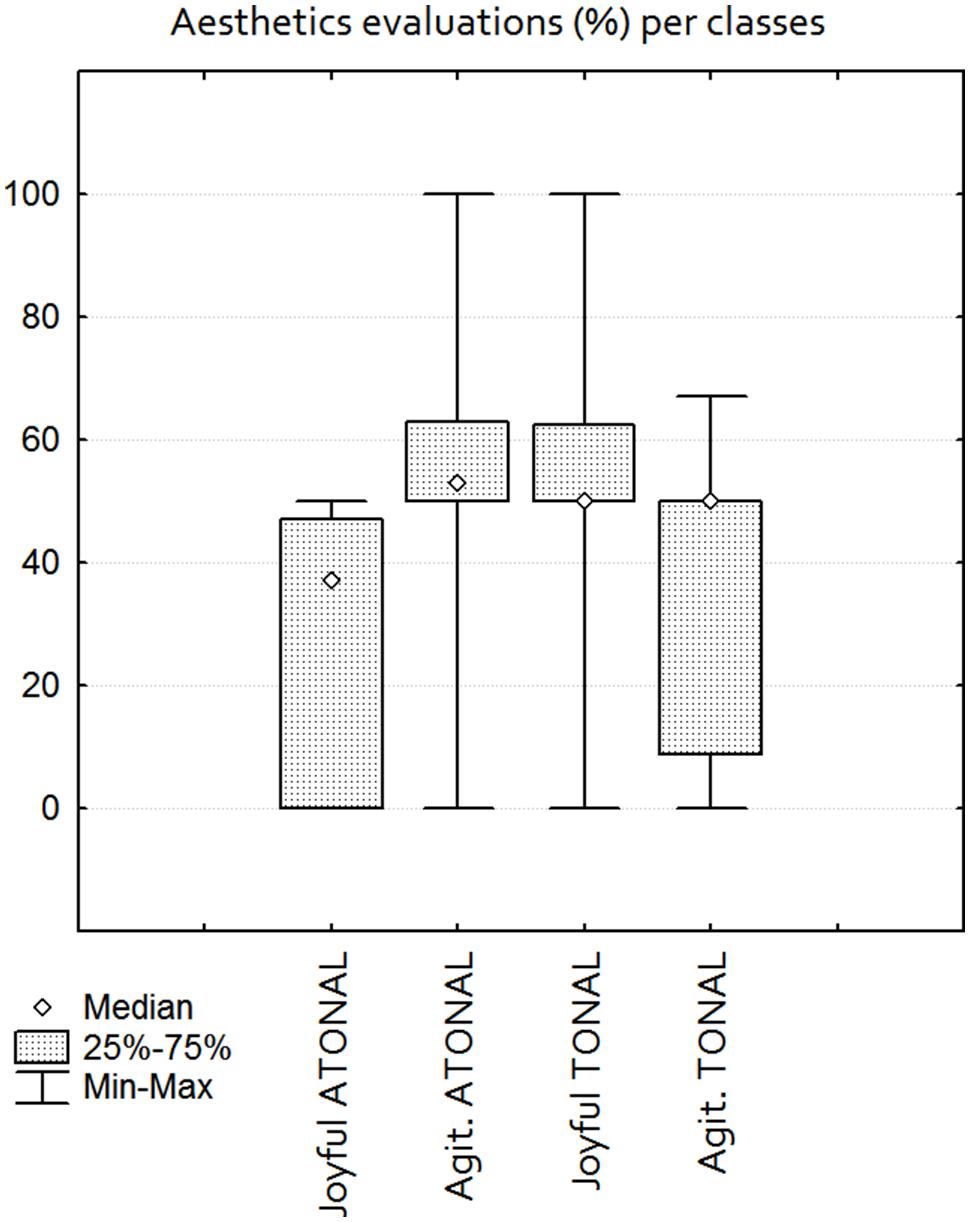
FIGURE 3. Results of the paired-samples Wilcoxon rank-sum test applied to the percentage of agitating vs. joyful evaluations attributed to pieces belonging to the two repertoires. Atonal pieces were judged to be significantly more agitating (i.e., as inducing tension) than tonal pieces, which were more frequently labeled as joyful. No difference whatsoever was found in the frequency with which a piece was judged to be touching (i.e., able to induce pathos) across the two repertoires. This finding is in contrast with the conclusions advanced by Kallinen (2005) that: (i) modern music does not intend to portray emotions; (ii) the meaning of musical emotional qualities in modern music is not as well-established as it is with regard to older music.
The most coherently evaluated pieces were examined for their similarities in structure, rhythm, and ensemble instrumentation across the two classes of tonal and atonal repertoires. Table 1 reports the pieces that received the largest number of coherent evaluations. The selected pieces are highlighted in bold. Based on the constraints imposed by the experimental paradigm, a single piece was selected for each stylistic and emotional category according to a set of criteria that guaranteed intracategoric homogeneity. These were:
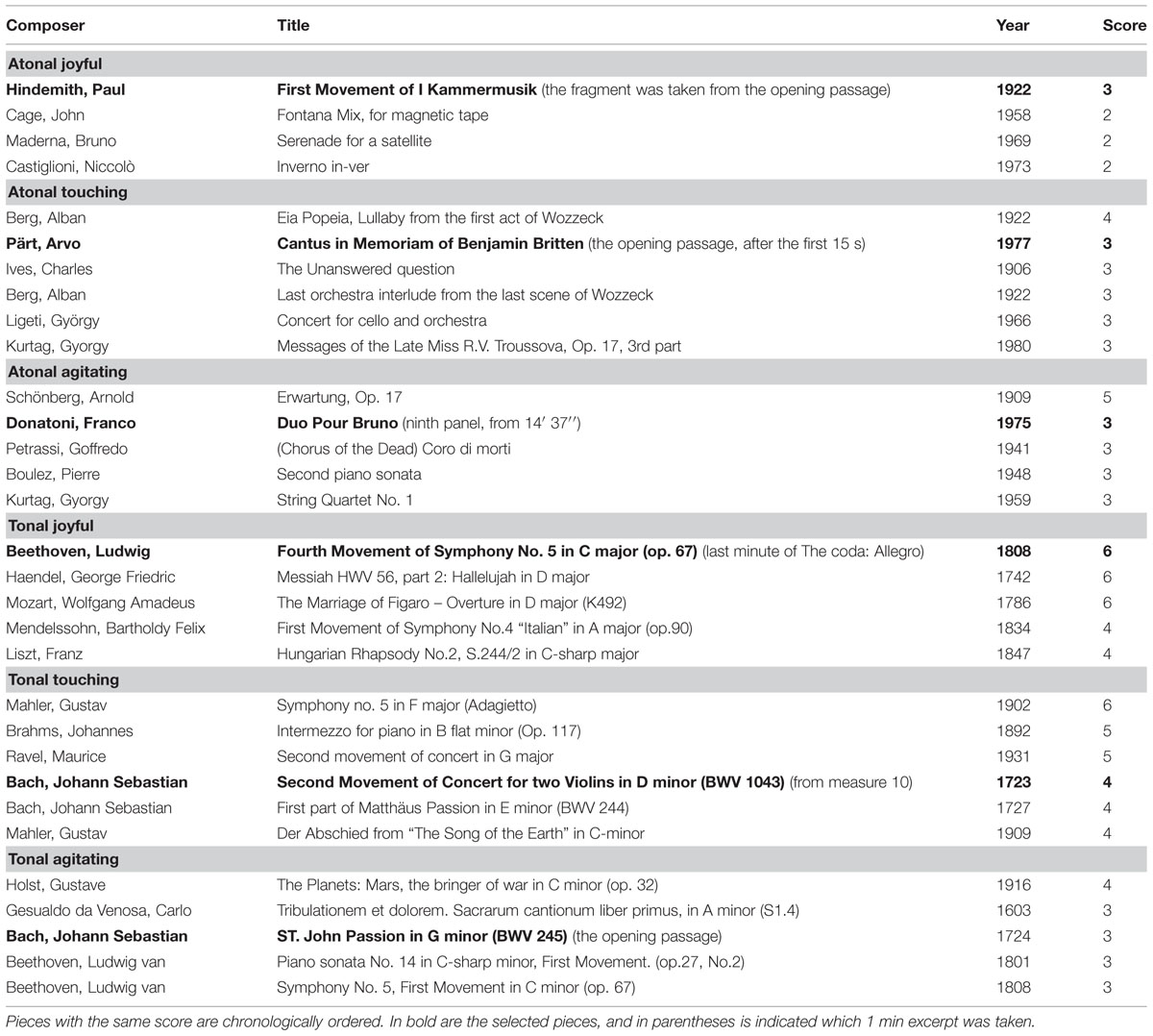
TABLE 1. List of musical pieces selected more frequently and coherently by judges to represent each stylistic and affective category.
(a) Absence of the human voice. On the basis of this principle, “Eia Popeia” by Alban Berg (from the atonal-touching category) was discarded. “Erwartung” by Arnold Schönberg (from the atonal-agitating category) was also discarded.
(b) Composition and size of the instrumental ensemble. On the basis of this principle, piano solo pieces were discarded (Brahms’s intermezzo for piano, Ravel’s concert in G major) from the tonal-sad category.
(c) Tempo and rhythmic structure. On the basis of this principle, Bach’s (and not Mahler’s) and Parvo’s (and not Ives’s) touching pieces were selected as more comparable to each other. Please see here the technical ratio1.
(d) Stylistic distinctiveness. According to this criterion, “The Planets: Mars, the Bringer of War in C minor” was discarded in that it is not completely tonal in nature. This piece seems to have an undefined tonal structure. It ends with the C chord using only the root and the fifth, and without the third. Therefore, the chord could be interpreted to be either C-major or C-minor. Holst uses only triads, which follow none of the traditional harmonic progressions according to the diatonic scale degree. Db-major appears to be the tonal center together with the basso ostinato on the note G. Both the Db-major and the basso ostinato on the note G appear to promote the idea of bitonality (Leelasiri, 2001).
For each of the selected pieces, taken from commercially available CDs, 1 min of connotative track was obtained by cutting the soundtrack via mp3 DirectCut and Format Factory software. Audio clips were faded at the end (in the last second) via Audacity software. Sound tracks were accurately matched for intensity with MP3Gain software (89.0 dB).
The six selected pieces were evaluated for their familiarity by a group of 10 university students (mean age = 22.7 years) from the same cohort of experimental subjects (i.e., non-musicians with no musical training) using a three-point scale (0 = no familiarity; 1 = somewhat familiar; 2 = familiar). Instructions informed subjects not to rate the piece by its typology (e.g., classical music, contemporary music, Baroque music) but specifically to rate the piece’s familiarity. In pieces that had some familiarity, subjects were asked to describe the exact circumstances in which they originally heard the piece (e.g., at the mall, at the airport, on TV, during a party, a concert, listening to a CD, MP3, etc.). The scores were submitted to ANOVA whose factors were style (tonal vs. atonal) and emotional tone (sad, happy, agitating). The musical pieces turned out to be very unfamiliar with no differences across classes (mean score = 0.3).
Fifty healthy participants (25 males and 25 females), ranging in age between 18 and 28 years (mean age = 22.2 years), took part to the study. They were all right-handed with normal hearing and vision and none had suffered from previous or current psychiatric or neurological diseases. Participants were recruited through Sona System (a system for recruiting students who earn credit for their psychology courses by participating in research studies), received academic credits for their participation and provided written informed consent. The experiment was performed in accordance with the relevant guidelines and regulations and was approved by the Ethical Committee of the University of Milano-Bicocca. The participants were blinded to the purpose of the experiment. None of the participants was a musician, and none of them had ever studied music, played a musical instrument, or had a musical activity as a hobby or specific interest. This information was specifically ascertained through the administration of a detailed questionnaire.
Subjects were comfortably seated in an anechoic chamber in dimly lit conditions. They wore headphones and a wrist device (on the left hand) for measuring heartbeat, and blood pressure (Diastolic = DiaBDLP and systolic = SysBDP) whose properties were: INNOFIT(INN-001) model, MWI technology (Precision: BLP ± 3 mmHg, heart rate ± 5%; range: 0–299 mmHg, 40/180 bpm). Participants faced a PC screen (through a mirror) located outside the cubicle, where they observed 300 faces to be remembered in a subsequent recall study. This kept their alertness levels even across the study. Faces were balanced for affective valence and perceived arousal across auditory blocks. The auditory stimulus was delivered through MP3 players. Each musical fragment was heard three times by each participant at different stages of the recording session. To limit the length of the experiment, half of the subjects were randomly assigned to the tonal or atonal conditions. The order of stimulus presentation varied randomly across subjects.
The individual values of average heart rate and blood pressure (both diastolic and systolic) recorded during the various music conditions underwent three ANOVAs with two factors of variability: music style (atonal vs. tonal), and emotion (agitating, joyful, touching). Tukey’s post hoc test was used for comparisons across means.
The ANOVA performed on heart rate values yielded the significance of music style [F(1,24) = 380; p < 0.000001], and heart frequency was lower while listening to atonal (71.3, SD = 2.18 bpm) over tonal music (77.4, SD = 2.18 bpm), as visible in Figure 4. Figure 5 displays the individual values of heart frequency recorded in healthy university students while listening to tonal or atonal musical pieces. No effect of emotion was visible except for a tendency of touching music to increase heart rate, particularly atonal music, as indicated by the significant Emotion × Style interaction [F(2,48) = 6.39; p < 0.0035], and relative post hoc comparisons.
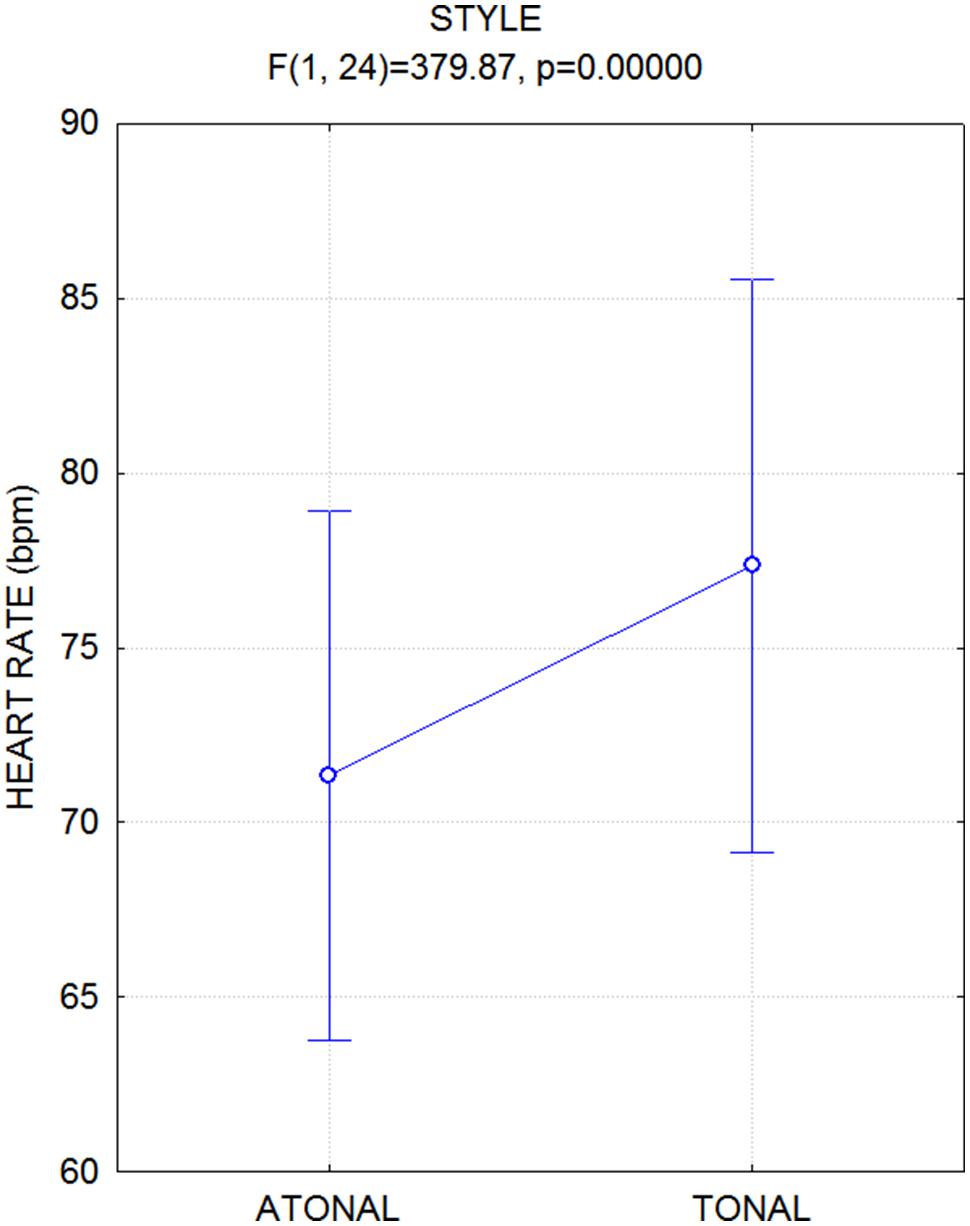
FIGURE 4. Mean values of heart rate (BPM), along with standard errors, recorded while participants listened to atonal vs. tonal music pieces.
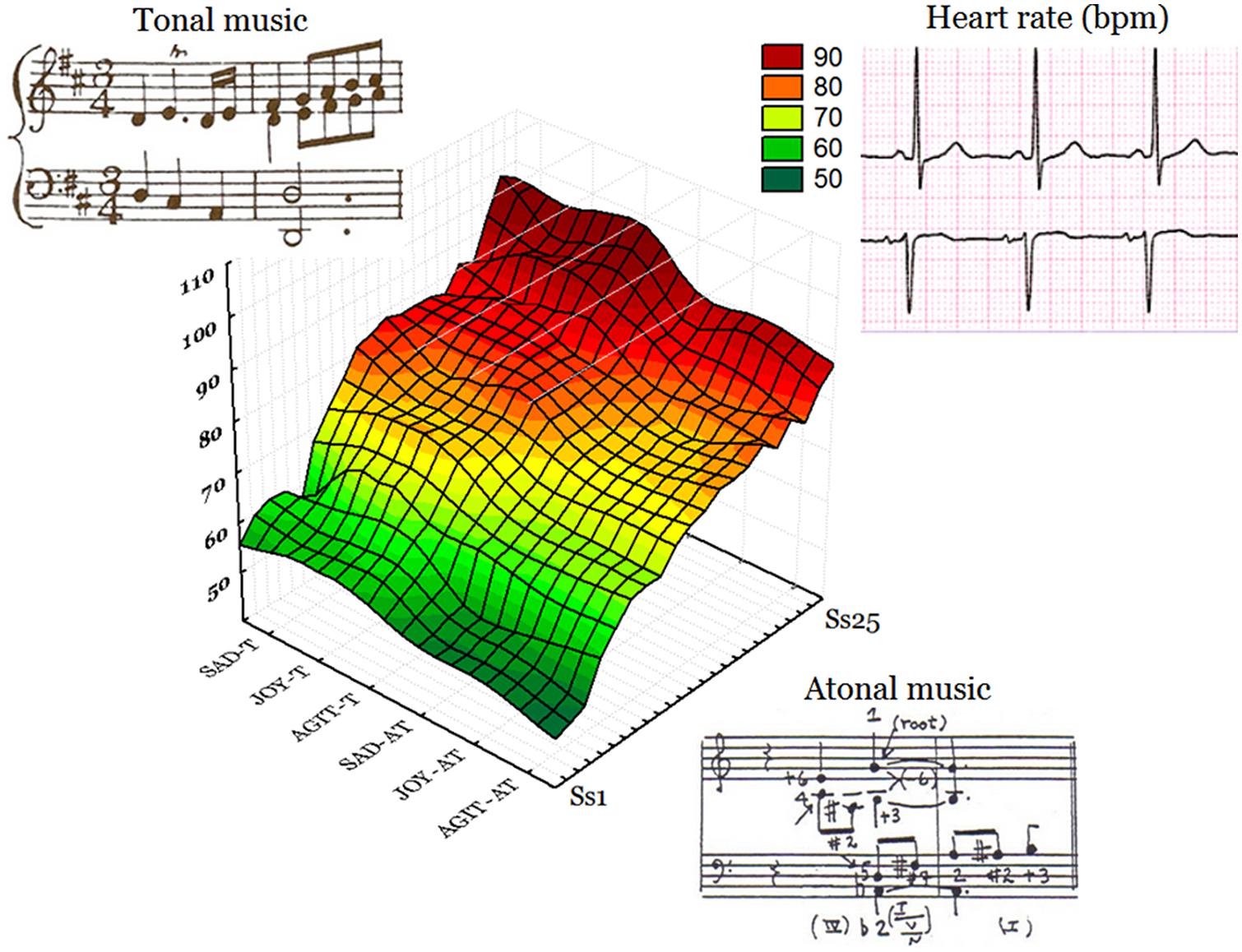
FIGURE 5. Individual values of heart frequency recorded in healthy university students while listening to tonal or atonal musical pieces. The latter condition was associated with a pronounced bradycardia (represented by a more extended green and yellow area). AGIT-AT = atonal agitating; JOY-AT = atonal joyful; SAD-AT = atonal touching; AGIT-T = tonal agitating; JOY-T = tonal joyful; SAD-T = tonal touching.
The ANOVA performed on diastolic blood pressure values yielded the significance of stimulus type [F(1,24) = 198; p < 0.000001], and sysBLP was higher overall while listening to all atonal vs. tonal pieces (see Figure 6). There was no significant effect of emotion.
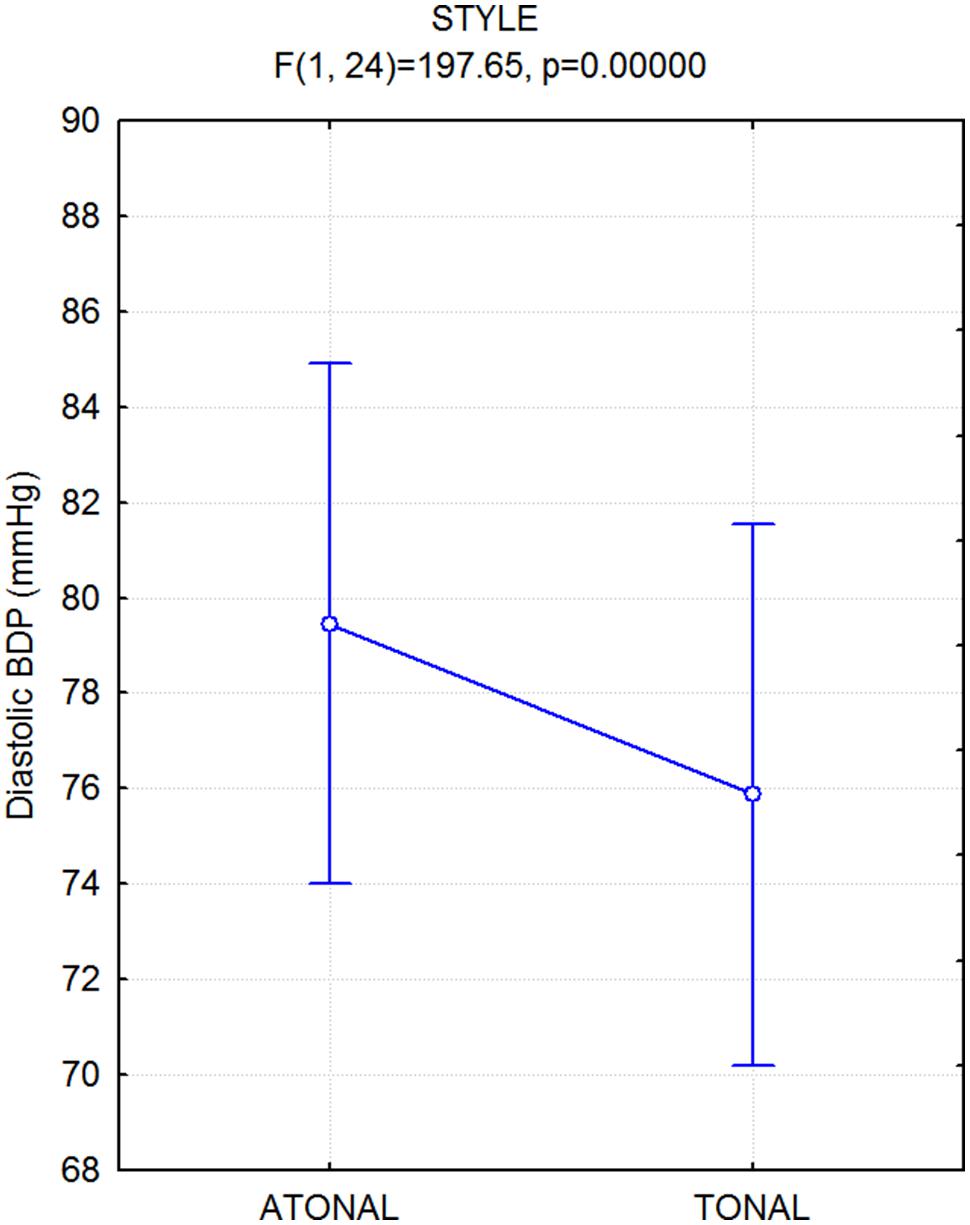
FIGURE 6. Mean values of diastolic blood pressure (diaBDP), along with standard errors, recorded while participants listened to atonal vs. tonal music pieces.
The ANOVA performed on systolic blood pressure values yielded the significance of music style [F(1,24) = 27.11; p < 0.000025], and sysBLP was higher overall while listening to all atonal rather than tonal pieces (see Figure 7). There was no significant effect of emotion.
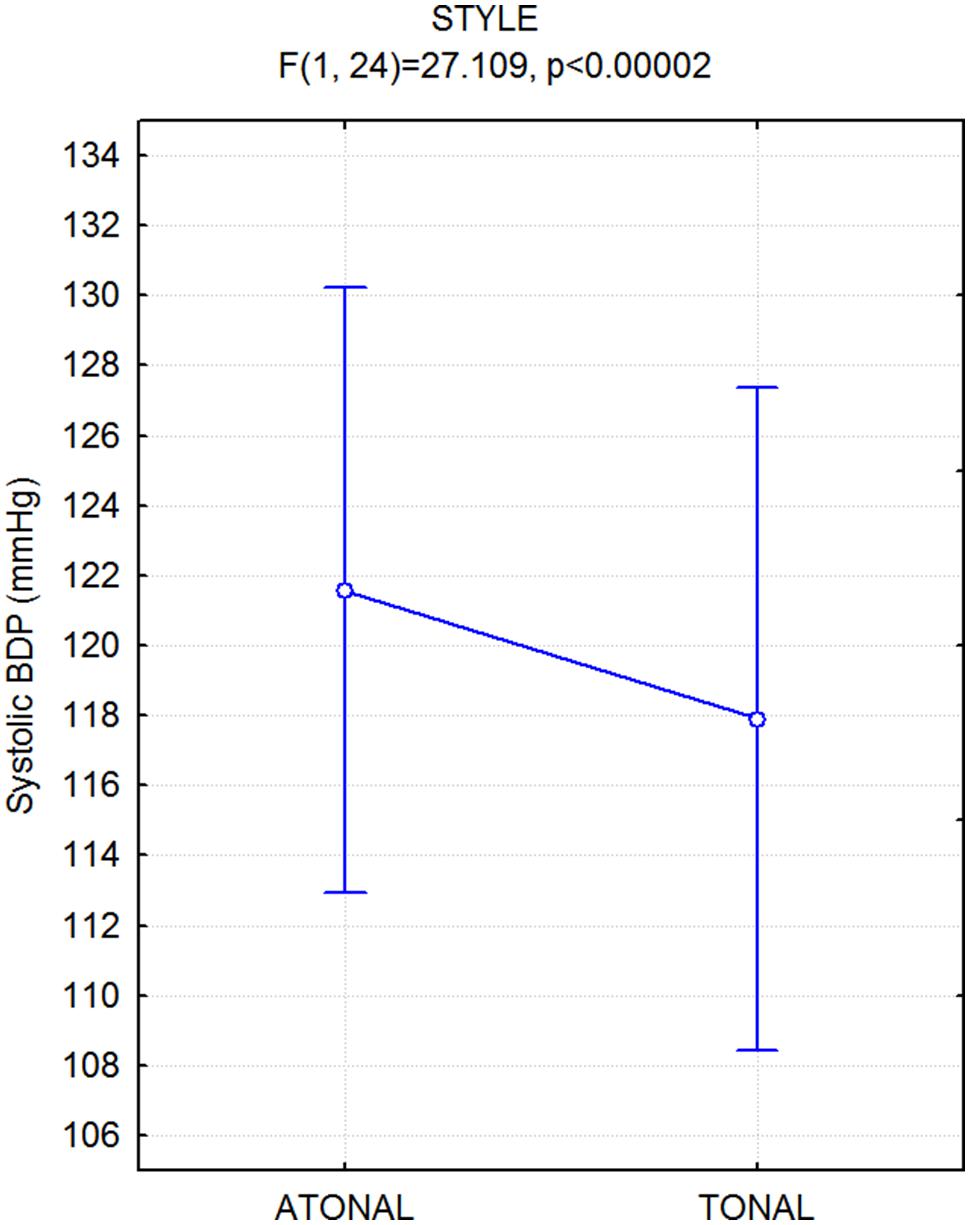
FIGURE 7. Mean values of systolic blood pressure (sysBDP), along with standard errors, recorded while participants listened to atonal vs. tonal music pieces.
Listening to instrumental atonal music (independent of the piece’s emotional characteristics) was associated with reduced heart rate (bradycardia) and increased blood pressure (both diastolic and systolic) compared to the tonal condition. Bradycardic changes of heartrate are associated with interest and attending to a stimulus (Coles and Duncan-Johnson, 1977; Hernández and Watson, 1997). Furthermore, bradycardic changes and increased blood pressure are associated with anxiety, tension and lack of relaxation. It is therefore possible that listening to atonal music might induce a parasympathetic response whose peripheral effects are sensed by the listener to be psychological tension and agitation. Indeed, according the esthetic assessment made by professional conductors and composers, the atonal repertoire is by definition more agitating. This interpretation fits very well with the findings commonly reported of a deceleration of the cardiac activity during perception of scary, threatening or noxious sounds. This defensive response is called fear-induced bradycardia, and is observable also in newborns (Anderssen et al., 1993). However, the psychophysiological literature is conflicting on this matter (i.e., the effects of agitating music on autonomic responses). For example, Hilz et al. (2014) monitored systolic and diastolic blood pressure while participants either sat in silence or listened to “relaxing” vs. “aggressive” excerpts of classical music. The results showed that listening to relaxing classical music and listening to aggressive classical music both increased systolic blood pressure, whereas the autonomic activation was lower under conditions of silence; therefore, aggressive music did not specifically increase blood pressure. The musical pieces were all tonal in this study, which might explain the lack of fear bradycardia. Our hypothesis is that the autonomic modulation found here is specifically related to the fearful aspects of atonal music, which was lacking in the music stimulation usually provided in previous psychophysiological studies.
Overall, by integrating psycho-esthetic with psychophysiological data from the present study, it can be hypothesized that the atonal music perception increased arousal and alertness to a greater extent than tonal music to the ears of non-musicians, as influenced by their auditory complexity and threatening properties. These notions are well-known to composers of thriller and horror movie soundtracks who make large use of dissonance and other expedients to scare audiences and create a sense of unease or dread (e.g., unresolved dissonances, timbral experimentation, unexpected recontextualization of a consonant and familiar-sounding musical work, atonality, stinger chords, repetitious drones, sudden changes in intensity, unpredictability, clashing dissonances; Lerner, 2009; Heimerdinger, 2012). These auditory stimuli have threatening and alerting properties, and may activate the amygdala, increase blood pressure, trigger an autonomic fear-related response, increase attention and excitability, and provide a psychological sense of anxiety (Davis and Whalen, 2001). Table 2 shows a musicological description of our atonal stimuli, suggesting their ability to create an intensely emotional, moving, threatening or wondrous feeling in the listener (regardless of their specific emotional label).
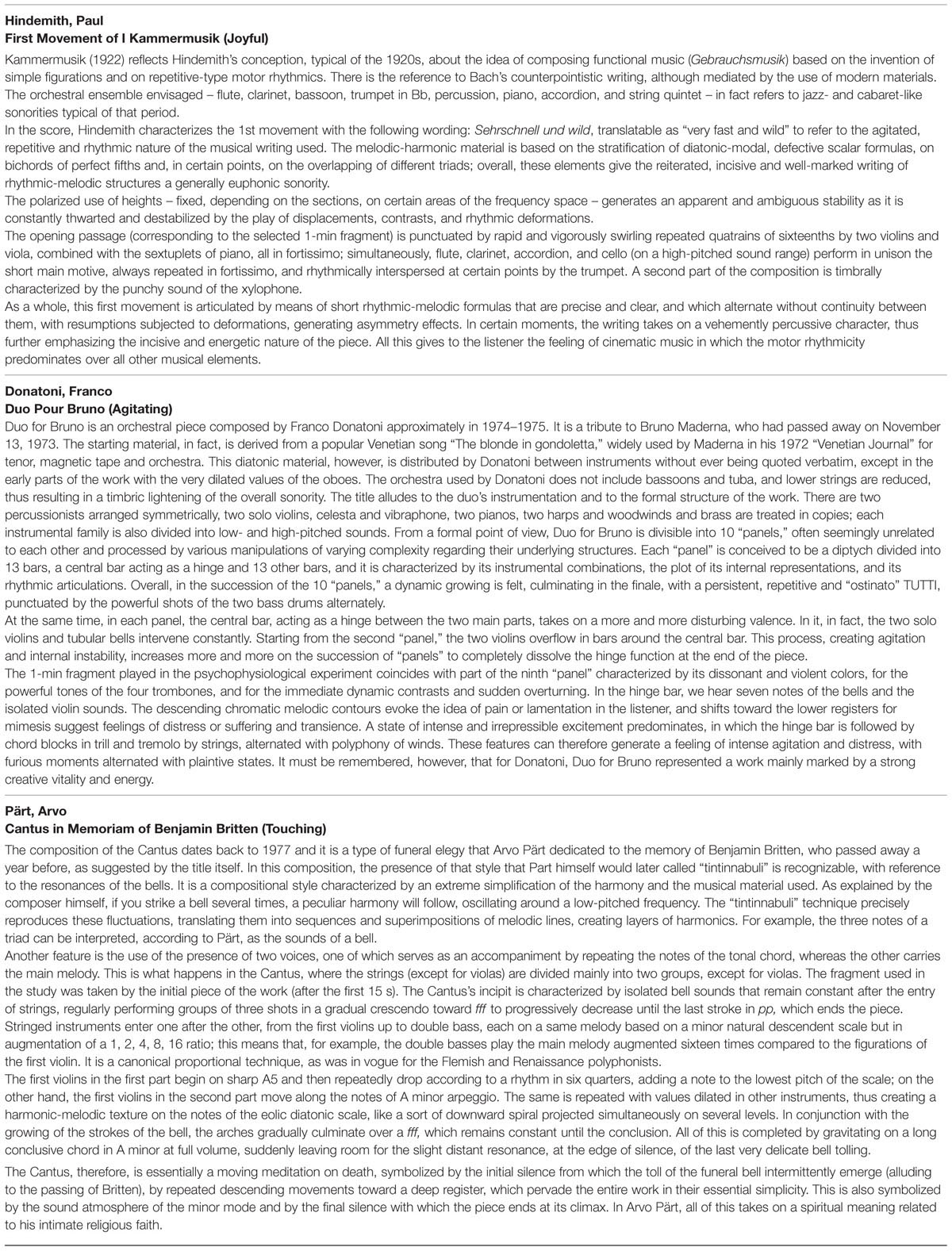
TABLE 2. Musicological characterization of atonal pieces used in the psychophysiological study. Aside from their being associated with a specific emotional state (i.e., joy, agitation and pathos, respectively) they shared some properties (described below), such as their ability to induce anxiety and psychological tension in listeners, along with their atonality.
The present findings show that the various music-induced emotions have a small modulatory effect on the vegetative response of ANS, in agreement with other psychophysiological studies providing negative (e.g., Etzel et al., 2006; Radstaak et al., 2014; Krabs et al., 2015), or inconsistent results (Iwanaga et al., 2005; Bernardi et al., 2006; Sammler et al., 2007; Tan et al., 2015). This pattern of autonomic responses suggests a fundamental difference with the cerebral responses to music, known to be clearly affected by the piece’s emotional connotation (Sammler et al., 2007; Salimpoor et al., 2011; Trost et al., 2012; Stupacher et al., 2013).
However, other data from our lab (Proverbio et al., 2015) with a larger group indicate that listening to touching musical pieces slightly but significantly increases heart rate (regardless or tonality) compared to environmental sounds (e.g., rain and thunder), suggesting that music is able to induce affective feelings regardless of compositional style. Other investigations are needed to determine the neural correlate of brain activation during music listening, which will likely highlight major differences as a function of music’s affective connotation (joyful vs. agitating vs. touching).
One of the limits of the study is the possibility of a culturally mediated difference in the esthetic preference for a tonal or atonal repertoire between the judges (who characterized the pieces as joyful, touching, and agitating) and naïve participants who listened to the selected pieces. Indeed, esthetic interviews were distributed to professional conductors and composers, who might have developed a positive esthetic taste for atonal music as a result of their specific profession. These judges concluded that the tonal and atonal repertoire was equally full of pathos and overall touching. On the other hand, we missed the esthetic evaluation of pieces from university students, who showed a strong difference in their autonomic responses to the tonal and the atonal pieces, possibly reflecting increased alertness and attention levels, a sense of wonder (feeling allured and amazed), psychological tension, and possibly anxiety and fear of the latter. The other possible limit relies in the concurrent visual stimulation. Indeed participants watched a sequence of 300 faces (balanced for affective valence and perceived arousal across auditory blocks) as a secondary task. Therefore they did not specifically pay attention to the auditory stimulation. If, on one hand, one might fear a cross modal interaction between auditory and visual processing (Marin et al., 2012), on the other hand, the inattentive auditory condition makes even more relevant the strong modulation of autonomic responses (fear bradycardia) which was found during listening to atonal music.
The authors declare that the research was conducted in the absence of any commercial or financial relationships that could be construed as a potential conflict of interest.
We are deeply indebted to our 20 anonymous judges who so generously contributed to this investigation and to all participants for their kind support.
Anderssen, S. H., Nicolaisen, R. B., and Gabrielsen, G. W. (1993). Autonomic response to auditory stimulation. Acta Paediatr. 82, 913–918. doi: 10.1111/j.1651-2227.1993.tb12598.x
Bernardi, L., Porta, C., and Sleight, P. (2006). Cardiovascular, cerebrovascular, and respiratory changes induced by different types of music in musicians and non-musicians: the importance of silence. Heart 92, 445–452. doi: 10.1136/hrt.2005.064600
Bidelman, G. M., and Heinz, M. G. (2011). Auditory-nerve responses predict pitch attributes related to musical consonance-dissonance for normal and impaired hearing. J. Acoust. Soc. Am. 130, 1488–1502. doi: 10.1121/1.3605559
Bidelman, G. M., and Krishnan, A. (2009). Neural correlates of consonance, dissonance, and the hierarchy of musical pitch in the human brainstem. J. Neurosci. 29, 13165–13171. doi: 10.1523/JNEUROSCI.3900-09.2009
Blood, A. J., and Zatorre, R. J. (2001). Intensely pleasurable responses to music correlate with activity in brain regions implicated in reward and emotion. Proc. Natl. Acad. Sci. U.S.A. 98, 11818–11823. doi: 10.1073/pnas.191355898
Brattico, E., and Pearce, M. T. (2013). The neuroaesthetics of music. Psychol. Aesthet. Crea. 7, 48–61. doi: 10.1037/a0031624
Chen, H. J., Chen, T. Y., Huang, C. Y., Hsieh, Y. M., and Lai, H. L. (2015). Effects of music on psychophysiological responses and opioid dosage in patients undergoing total knee replacement surgery. Jpn. J. Nurs. Sci. 12, 309–319. doi: 10.1111/jjns.12070
Coles, M. G., and Duncan-Johnson, C. C. (1977). Attention and cardiac activity: heart rate responses during a variable foreperiod, disjunctive reaction time task. Biol. Psychol. 5, 151–158. doi: 10.1016/0301-0511(77)90010-2
Crespo-Bojorque, P., and Toro, J. M. (2015). The use of interval ratios in consonance perception by rats (Rattus norvegicus) and humans (Homo sapiens). J. Comp. Psychol. 129, 42–51. doi: 10.1037/a0037991
Daynes, H. (2011). Listeners’ perceptual and emotional responses to tonal and atonal music. Psychol. Music 39, 468–502. doi: 10.1177/0305735610378182
Donin, N., and Feneyrou, L. (2013). Théories de la Composition Musicale au XXe Siècle, Vol. 2. Lyon: Symétrie.
Egermann, W., Pearce, M. T., Wiggins, G. A., and McAdams, S. (2013). Probabilistic models of expectation violation predict psychophysiological emotional responses to live concert music. Cogn. Affect. Behav. Neurosci. 13, 533–553. doi: 10.3758/s13415-013-0161-y
Etzel, J. A., Johnsen, E. L., Dickerson, J., Tranel, D., and Adolphs, R. (2006). Cardiovascular and respiratory responses during musical mood induction. Int. J. Psychophysiol. 61, 57–69. doi: 10.1016/j.ijpsycho.2005.10.025
Fishman, Y. I., Volkov, I. O., Noh, M. D., Garell, P. B. C., Bakken, H., Arezzo, J. B. C., et al. (2001). Consonance and dissonance of musical chords: neural correlates in auditory cortex of monkeys and humans. Neurophysiology 86, 2761–2788.
Gosselin, N., Peretz, I., Johnsen, E., and Adolphs, R. (2007). Amygdala damage impairs emotion recognition from music. Neuropsychologia 45, 236–244. doi: 10.1016/j.neuropsychologia.2006.07.012
Heimerdinger, J. (2012). Music and sound in the horror film & why some modern and avant-garde music lends itself to it so well. Seiltanz. Beiträge zur Musik der Gegenwart 4, 4–16.
Hermans, E. J., Henckens, M. J., Roelofs, K., and Fernández, G. (2013). Fear bradycardia and activation of the human periaqueductal grey. Neuroimage 1, 278–287. doi: 10.1016/j.neuroimage.2012.10.063
Hernández, L. L., and Watson, K. L. (1997). Opioid modulation of attention-related responses: delta-receptors modulate habituation and conditioned bradycardia. Psychopharmacology 131, 140–147. doi: 10.1007/s002130050276
Hilz, M. J., Stadler, P., Gryc, T., Nath, J., Habib-Romstoeck, L., Stemper, B., et al. (2014). Music induces different cardiac autonomic arousal effects in young and older persons. Auton Neurosci. 183, 83–93. doi: 10.1016/j.autneu.2014.02.004
Hopyan, T., Manno, F. A., Papsin, B. C., and Gordon, K. A. (2015). Sad and happy emotion discrimination in music by children with cochlear implants. Child Neuropsychol. 6, 1–15. doi: 10.1080/09297049.2014.992400
Huron, D. (2013). Why is sad music pleasurable? A possible role for prolactin. Musicae Sci. 150, 46–58.
Iwanaga, M., Kobayashi, A., and Kawasaki, C. (2005). Heart rate variability with repetitive exposure to music. Biol. Psychol. 70, 61–66. doi: 10.1016/j.biopsycho.2004.11.015
Jacobsen, T. (2010). Beauty and the brain: culture, history and individual differences in aesthetic appreciation. J. Anat. 216, 184–191. doi: 10.1111/j.1469-7580.2009.01164.x
Janata, P. (2009). The neural architecture of music-evoked autobiographical memories. Cereb. Cortex 19, 2579–2594. doi: 10.1093/cercor/bhp008
Kalin, N. H., Shelton, S. E., Davidson, R. J., and Lynn, D. E. (1996). A new method for aversive Pavlovian conditioning of heart rate in rhesus monkeys. Physiol. Behav. 60, 1043–1046. doi: 10.1016/0031-9384(96)00145-X
Kallinen, K. (2005). Emotional ratings of music excerpts in the western art music repertoire and their self-organization in the Kohonen neural network. Psychol. Music 33, 373–394. doi: 10.1177/0305735605056147
Kawakami, A., Furukawa, K., Katahira, K., and Okanoya, K. (2013). Sad music induces pleasant emotion. Front. Psychol. 13:311. doi: 10.3389/fpsyg.2013.00311
Koelsch, S. (2014). Brain correlates of music-evoked emotions. Nat. Rev. Neurosci. 15, 170–180. doi: 10.1038/nrn3666
Koelsch, S., Fritz, T., von Cramon, D. Y., Muller, K., and Friederici, A. D. (2006). Investigating emotion with music: an fMRI study. Hum. Brain Mapp. 27, 239–250. doi: 10.1002/hbm.20180
Konecni, V. J. (1979). Determinants of aesthetic preference and effects of exposure to aesthetic stimuli: social, emotional and cognitive factors. Prog. Exp. Pers. Res. 9, 149–197.
Krabs, R. U., Enk, R., Teich, N., and Koelsch, S. (2015). Autonomic effects of music in health and Crohn’s disease: the impact of isochronicity, emotional valence, and tempo. PLoS ONE 10:e0126224. doi: 10.1371/journal.pone.0126224
Leelasiri, K. (2001). An analysis of Gustav Holsts’ the Planets, thesis, Master of Arts in Music California State University, Northridge.
Lerner, N. (2009). Music in the Horror Film: Listening to Fear. Routledge Music and Screen Media. New York: Taylor and Francis.
Liégeois-Chauvel, C., Bénar, C., Krieg, J., Delbé, C., Chauvel, P., Giusiano, B., et al. (2014). How functional coupling between the auditory cortex and the amygdala induces musical emotion: a single case study. Cortex 60, 82–93. doi: 10.1016/j.cortex.2014.06.002
Marin, M. M., Gingras, B., and Bhattacharya, J. (2012). Crossmodal transfer of arousal, but not pleasantness, from the musical to the visual domain. Emotion 12, 618–631. doi: 10.1037/a0025020
Minati, L., Rosazza, C., D’Incerti, L., Pietrocini, E., Valentini, L., Scaioli, V., et al. (2009). Functional MRI/event-related potential study of sensory consonance and dissonance in musicians and nonmusicians. Neuroreport 7, 87–92. doi: 10.1097/WNR.0b013e32831af235
Ockelford, J., and Sergeant, E. (2012). Musical expectancy in atonal contexts: musicians’ perception of “antistructure”. Psychol. Music 41, 139–174.
Palomba, D., Sarlo, M., Angrilli, A., Mini, A., and Stegagno, L. (2000). Cardiac responses associated with affective processing of unpleasant film stimuli. Int. J. Psychophysiol. 36, 45–57. doi: 10.1016/S0167-8760(99)00099-9
Pearce, M. T., and Wiggins, G. A. (2012). Auditory expectation: the information dynamics of music perception and cognition. Top. Cogn. Sci. 4, 625–652. doi: 10.1111/j.1756-8765.2012.01214.x
Perani, D., Saccuman, M. C., Scifo, P., Spada, D., Andreolli, G., Rovelli, R., et al. (2010). Functional specializations for music processing in the human newborn brain. Proc. Natl. Acad. Sci. U. S. A. 107, 4758–4763. doi: 10.1073/pnas.0909074107
Peretz, I., and Zatorre, R. (eds). (2003). The Cognitive Neuroscience of Music. Oxford: Oxford University Press.
Proverbio, A. M., Lozano Nasi, V., Arcari, L. A., De Benedetto, F., Guardamagna, M., Gazzola, M., et al. (2015). The effect of background music on episodic memory and autonomic responses: listening to emotionally touching music enhances facial memory capacity. Sci. Rep. 5:15219. doi: 10.1038/srep15219
Radstaak, M., Geurts, S. A., Brosschot, J. F., and Kompier, M. A. (2014). Music and psychophysiological recovery from stress. Psychosom. Med. 76, 529–537. doi: 10.1097/PSY.0000000000000094
Salimpoor, V., Benovoy, M., Larcher, K., Dagher, A., and Zatorre, R. J. (2011). Anatomically distinct dopamine release during anticipation and experience of peak emotion to music. Nat. Neurosci. 14, 257–262. doi: 10.1038/nn.2726
Sammler, D., Grigutsch, M., Fritz, T., and Koelsch, S. (2007). Music and emotion: electrophysiological correlates of the processing of pleasant and unpleasant music. Psychophysiology 44, 293–304. doi: 10.1111/j.1469-8986.2007.00497.x
Stupacher, J., Hove, M. J., Novembre, G., Schutz-Bosbach, S., and Keller, P. E. (2013). Musical groove modulates motor cortex excitability: a TMS investigation. Brain Cogn. 82, 127–136. doi: 10.1016/j.bandc.2013.03.003
Sugimoto, T., Kobayashi, H., Nobuyoshi, N., Kiriyama, Y., Takeshita, H., Nakamura, T., et al. (2010). Preference for consonant music over dissonant music by an infant chimpanzee. Primates 51, 7–12. doi: 10.1007/s10329-009-0160-3
Tan, F., Tengah, A., Nee, L. Y., and Fredericks, S. (2014). A study of the effect of relaxing music on heart rate recovery after exercise among healthy students. Complement Ther. Clin. Pract. 20, 114–117. doi: 10.1016/j.ctcp.2014.01.001
Tan, Y. Z., Ozdemir, S., Temiz, A., and Celik, F. (2015). The effect of relaxing music on heart rate and heart rate variability during ECG GATED-myocardial perfusion scintigraphy. Complement. Ther. Clin. Pract. 21, 137–140. doi: 10.1016/j.ctcp.2014.12.003
Trost, W., Ethofer, T., Zentner, M., and Vuilleumier, P. (2012). Mapping aesthetic musical emotions in the brain. Cereb. Cortex 22, 2769–2783. doi: 10.1093/cercor/bhr353
Van Puyvelde, M., Loots, G., Vanfleteren, P., Meys, J., Simcock, D., and Pattyn, N. (2014). Do You Hear the Same? Cardiorespiratory responses between mothers and infants during tonal and atonal music. PLoS ONE 9:e106920. doi: 10.1371/journal.pone.0106920
Virtala P., Huotilainen, M., Putkinen, V., Makkonen, T., and Tervaniemi, M. (2012). Musical training facilitates the neural discrimination of major versus minor chords in 13-year-old children. Psychophysiology 49, 1125–1132. doi: 10.1111/j.1469-8986.2012.01386.x
Vuilleumier, P., and Trost, W. (2015). Music and emotions: from enchantment to entrainment. Ann. N. Y. Acad. Sci. 1337, 212–222. doi: 10.1111/nyas.12676
Young, B. J., and Leaton, R. N. (1994). Fear potentiation of acoustic startle stimulus-evoked heart rate changes in rats. Behav. Neurosci. 108, 1065–1079. doi: 10.1037/0735-7044.108.6.1065
Zentner, M., Grandjean, D., and Scherer, K. R. (2008). Emotions evoked by the sound of music: characterization, classification, and measurement. Emotion 8, 494–521. doi: 10.1037/1528-3542.8.4.494
Keywords: neuroesthetics, music perception, heart rate, dissonance, auditory processing, emotions, empirical musicology, psychophysiology
Citation: Proverbio AM, Manfrin L, Arcari LA, De Benedetto F, Gazzola M, Guardamagna M, Lozano Nasi V and Zani A (2015) Non-expert listeners show decreased heart rate and increased blood pressure (fear bradycardia) in response to atonal music. Front. Psychol. 6:1646. doi: 10.3389/fpsyg.2015.01646
Received: 15 July 2015; Accepted: 12 October 2015;
Published: 28 October 2015.
Edited by:
Elvira Brattico, Aarhus University, FinlandReviewed by:
Diana Omigie, Goldsmiths, University of London, UKCopyright © 2015 Proverbio, Manfrin, Arcari, De Benedetto, Gazzola, Guardamagna, Lozano Nasi and Zani. This is an open-access article distributed under the terms of the Creative Commons Attribution License (CC BY). The use, distribution or reproduction in other forums is permitted, provided the original author(s) or licensor are credited and that the original publication in this journal is cited, in accordance with accepted academic practice. No use, distribution or reproduction is permitted which does not comply with these terms.
*Correspondence: Alice M. Proverbio, bWFkby5wcm92ZXJiaW9AdW5pbWliLml0
Disclaimer: All claims expressed in this article are solely those of the authors and do not necessarily represent those of their affiliated organizations, or those of the publisher, the editors and the reviewers. Any product that may be evaluated in this article or claim that may be made by its manufacturer is not guaranteed or endorsed by the publisher.
Research integrity at Frontiers

Learn more about the work of our research integrity team to safeguard the quality of each article we publish.